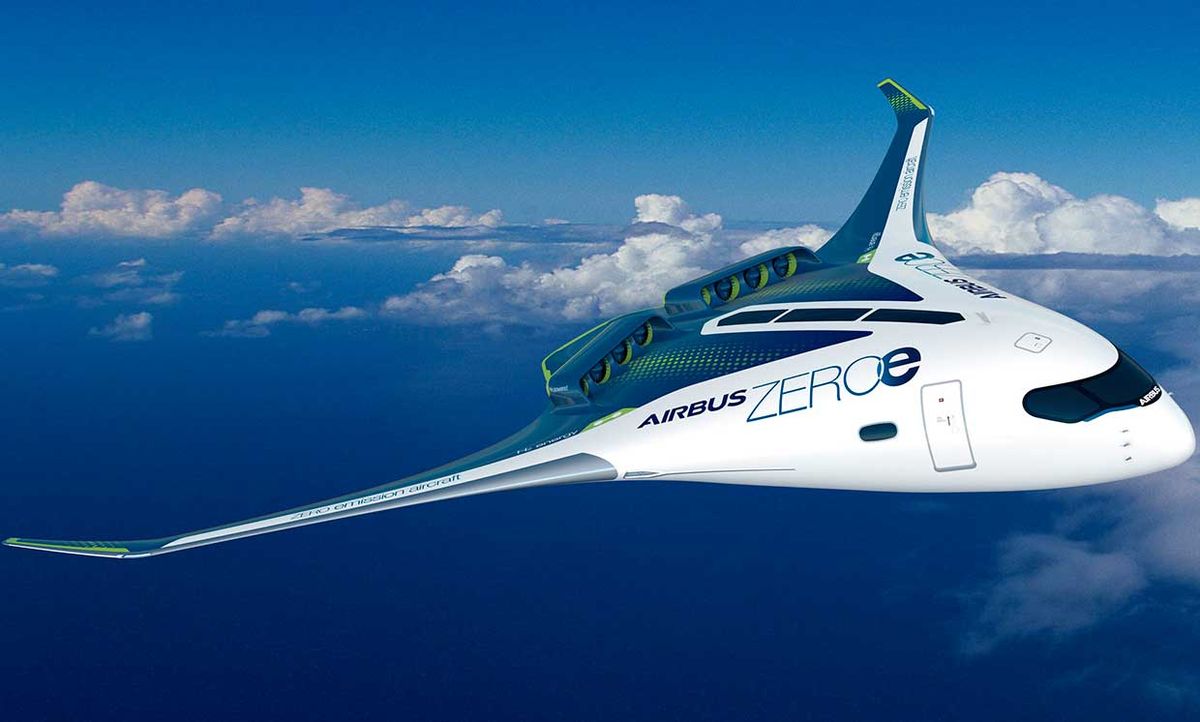Imagine that it is 2035, and you are flying home to be with family for the holidays. Airports and planes have not changed much since your childhood: Your flight is late as usual. But the Airbus jet at your gate is different. It is a giant V-shaped blended-wing aircraft, vaguely reminiscent of a boomerang. The taper of the wings is so gentle that one cannot really say where the fuselage ends and the wings begin. The plane is a big lifting body, with room for you and 200 fellow passengers.
One other important thing you notice before you board: The plane is venting vapor, a lot of it, even on a crisp morning. That, you know, is because the plane is fueled by liquid hydrogen, cooled to -253 degrees C, which boils off despite the plane’s extensive insulation. This is part of the vision Airbus, the French-based aviation giant, presents as part of its effort against global climate change.
Airbus is now betting heavily on hydrogen as a fuel of the future. It has just unveiled early plans for three “ZEROe” airliners, each using liquid hydrogen to take the place of today’s hydrocarbon-based jet-fuel compounds.
“It is really our intent in 15 years to have an entry into service of a hydrogen-powered airliner,” says Amanda Simpson, vice president for research and technology at Airbus Americas. Hydrogen, she says, “has the most energy per unit mass of…well, anything. And because it burns with oxygen to [yield] water, it is entirely environmentally friendly.”
But is a hydrogen future realistic for commercial aviation? Is it practical from an engineering, environmental, or economic standpoint? Certainly, people at Airbus say they need to decarbonize, and research on battery technology for electric planes has been disappointing. Meanwhile, China, currently the world’s largest producer of carbon dioxide, pledged last month to become carbon neutral by 2060. And 175 countries have signed on to the 2015 Paris agreement to fight global warming.
According to the European Commission, aviation alone accounts for between 2 and 3 percent of the world’s greenhouse gas emissions – about as much as entire countries like Japan or Germany.
Two of the planes Airbus has shown in artist renditions would barely get a second glance at today’s airports. One—with a capacity of 120-200 passengers, a cruising speed of about 830 kilometers per hour (kph), and a range of more than 3,500 km—looks like a conventional twin-engine jet. The second looks like almost any other turboprop you’ve ever seen; it’s a short-haul plane that can carry up to 100 passengers with a range of at least 1,800 km and a cruising speed of 612 kph. Each plane would get electric power from fuel cells. The company said it won’t have most other specifications for several years; it said to think of the images as “concepts,” meant to generate ideas for future planes.

The third rendering, an illustration of that blended-wing aircraft, showed some of the potential—and potential challenges—of hydrogen as a fuel. Airbus said the plane might have a cruising speed of 830 kph and a range of 3,500 km, without releasing carbon into the air. Liquid hydrogen contains about three times as much energy in each kilogram as today’s jet fuel. On the other hand, a kilogram of liquid hydrogen takes up three times the space. So, a plane would need either to give up cabin space or have more inside volume. A blended wing, with its bulbous shape, Airbus says, may solve the problem. And as a bonus, blended wings have shown they can be 20 percent more fuel-efficient than today’s tube-and-wing aircraft.
“My first reaction is: Let’s do it. Let’s make it happen,” says Daniel Esposito, a chemical engineer at Columbia University whose research covers hydrogen production. He says hydrogen can be handled safely and has a minimal carbon footprint if it’s made by electrolysis (splitting water into hydrogen and oxygen) using renewable electricity. Most industrial hydrogen today is extracted from natural gas, which negates some of the carbon benefit, but the International Energy Agency says that with renewable electricity capacity quickly growing (it passed coal as a power source in 2019), the cost of carbon-free hydrogen could drop.
“It can be done,” he says. “It’s just a matter of the political will and the will of companies like Airbus and Boeing to take the lead on this.”
Others have their doubts. “A lot of these things, you can; the question is, should you?” says Richard Pat Anderson, a professor of aerospace engineering at Embry-Riddle Aeronautical University. “When we say, ‘Should you?’ and you get into economics, then it becomes a much more difficult conversation.” Anderson says battery-powered aircraft are likely to become practical later in this century, and it is a dubious proposition to build the massive – and costly – infrastructure for hydrogen power in the meantime.
But in a warming world, Airbus says, the aviation sector needs to get going. McKinsey & Company, the consulting firm, surveyed airline customers last year and found 62 percent of younger fliers (under age 35) “really worried about climate change” and agreed that “aviation should definitely become carbon neutral.”
So, you’re on that jetway 15 years from now, on the way home. What will power the plane you’re boarding?
“Hydrogen is coming,” says Simpson at Airbus. “It’s already here.”
Ned Potter is a New York writer who spent more than 25 years as an ABC News and CBS News correspondent covering science, technology, space, and the environment.



